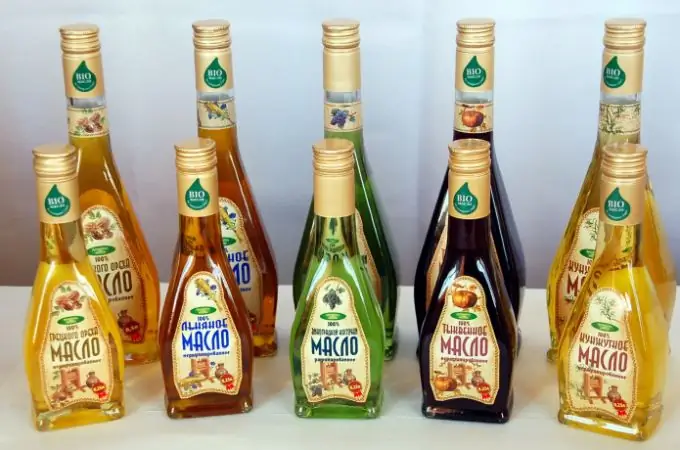- Author Brandon Turner [email protected].
- Public 2023-12-17 01:37.
- Last modified 2025-01-24 11:12.
Vegetable oil is a product obtained from the seeds or fruits of plants. The most popular are olive, corn and sunflower oils, which are added to salads, mayonnaise is prepared on their basis and used for frying.

Vegetable oil is a product that is obtained from seeds or fruits of plants by pressing or extraction. The source of obtaining vegetable oil can be oil-containing waste of processing and nuts. In terms of consistency, oils can be solid and liquid, and in terms of their ability to form a film upon drying, they can be drying, semi-drying and non-drying.
Useful properties and calorie content
Vegetable oils are the most important source of polyunsaturated fatty acids that are not synthesized by the human body. Linoleic and linolenic acids fight atherosclerosis - the most common cause of heart and vascular diseases, as well as cerebral circulation disorders. They are involved in the synthesis of structural components of cell membranes, which are responsible for the normal functioning of the latter and their resistance to damage. Polyunsaturated fatty acids accelerate the metabolism in the liver.
Phospholipids, which are part of vegetable oils, regulate fat metabolism, protect tissue cells and ensure their growth and reproduction. Vitamin A is a powerful antioxidant that increases the body's defenses. Vitamin E is considered the vitamin of youth and is essential for women to maintain their reproductive health. Vitamin D promotes the growth of teeth and bones.
The calorie content of vegetable oils varies from 800 to 990 Kcal per 100 g of product. Such high calorie values are compensated by the increased degree of absorption of the product and the complete breakdown of these calories. This factor significantly depends on the production method and the content of polyunsaturated fatty acids in the oil.
Types of vegetable oils
The consumption of vegetable oils in Russia is dominated by sunflower oil obtained from sunflower seeds. On its basis, margarine and mayonnaise are produced, canned vegetables and fish are made. On sale you can find refined and unrefined sunflower oil. A refined product has no odor, but an unrefined one, as a rule, has a dark color and a strong specific smell.
Peanut butter is a product of peanut processing. The unrefined product has a reddish brown color, while the refined product has a straw yellow color. Various products are fried in peanut butter, it is added to salads and dough. Mustard oil is obtained by pressing the seed of oily mustard varieties. The color of this product is yellow with a greenish tinge. The oil has a rather specific taste, which imposes restrictions on its use.
An odorless product with a rather pleasant taste is sesame oil. It contains quite a bit of vitamin E and no vitamin A. It is used in the canning and confectionery industries, as well as for technical purposes. The chemical composition of corn oil is similar to that of its sunflower counterpart. The content of linoleic acid in it reaches 50%. The refined product is used for making dough, mayonnaise, frying and dressing salads.
Olive oil is an expensive, elite product obtained by pressing the pulp of olives. And although it is lower in essential fatty acids and vitamin E than other oils, it is extremely beneficial and widely used by housewives around the world.






